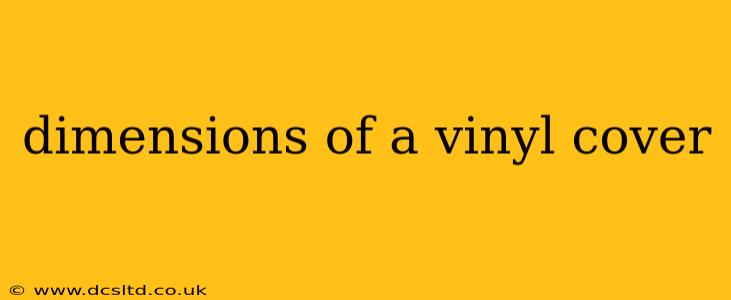Vinyl records have experienced a remarkable resurgence in popularity, captivating music lovers with their warm sound and tangible nature. But beyond the music itself lies the artwork – the iconic vinyl record cover. Understanding the dimensions of these covers is crucial for artists, designers, and collectors alike. This guide will delve into the standard sizes, variations, and considerations for vinyl cover dimensions.
What are the standard dimensions of a vinyl record cover?
The most common size for a vinyl record cover is 12 inches by 12 inches (30.5 cm x 30.5 cm). This square format perfectly accommodates the 12-inch LP record itself, allowing for ample space for artwork, liner notes, and track listings. This is the standard for most albums released throughout history.
However, it's important to note that this is just the outer dimension. The area for actual printing might be slightly smaller due to bleed and margins. Always check with your printing service provider for specifics on their printing area.
What about 7-inch vinyl covers?
7-inch vinyl records, also known as singles, have their own unique cover dimensions. While they can vary slightly depending on the manufacturer, they generally measure approximately 7 inches by 7 inches (17.8 cm x 17.8 cm), mirroring the square format of their 12-inch counterparts. Again, the printable area will be slightly smaller than these overall dimensions.
Are there any variations in vinyl cover sizes?
While the 12x12 and 7x7 inch formats are the most prevalent, minor variations can exist. Some independent labels or artists might choose non-standard sizes, though this is less common. Gatefold covers, which fold open to reveal more artwork, will have a different unfolded size. This unfolded size is typically twice the width of the standard 12-inch cover.
How do I determine the printable area of my vinyl cover?
Before designing your artwork, it's crucial to know the printable area provided by your chosen printing service. Each printing company has slight differences in their bleed and margin requirements. Contacting your printer directly and requesting their specifications is paramount to avoid any issues with cropping or wasted space. They will provide you with the exact dimensions within which your design must fall to ensure proper printing.
What are the considerations for designing vinyl covers?
Designing a vinyl cover involves more than just choosing the right dimensions. You also need to consider:
- Image resolution: High-resolution images are crucial for sharp and crisp printing.
- Color profiles: Ensuring your artwork uses the correct color profile (often CMYK) will prevent color discrepancies in the final print.
- File formats: Your printing service will have specific requirements for file formats (e.g., PDF, TIFF).
- Bleed: Leaving a bleed area around your design allows for accurate trimming without any white edges.
What is the best paper stock for vinyl record covers?
The choice of paper stock significantly influences the final feel and quality of your vinyl cover. Common choices include:
- Cardboard: A classic and robust choice offering durability.
- Thick Paper Stock: Provides a high-quality feel but may not be as durable as cardboard.
- Specialty Paper Stocks: Many printing companies offer specialty stocks, including textured or coated papers, offering a unique aesthetic.
By carefully considering these factors and understanding the standard dimensions, you can create stunning and high-quality vinyl covers that perfectly complement the music within. Remember, always confirm the precise specifications with your chosen printing service to ensure a seamless production process.
